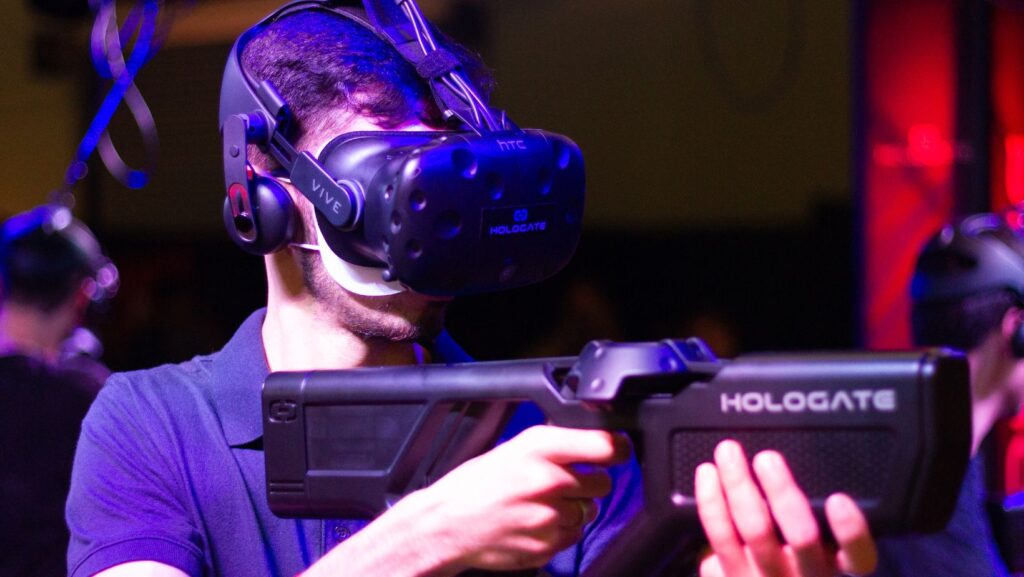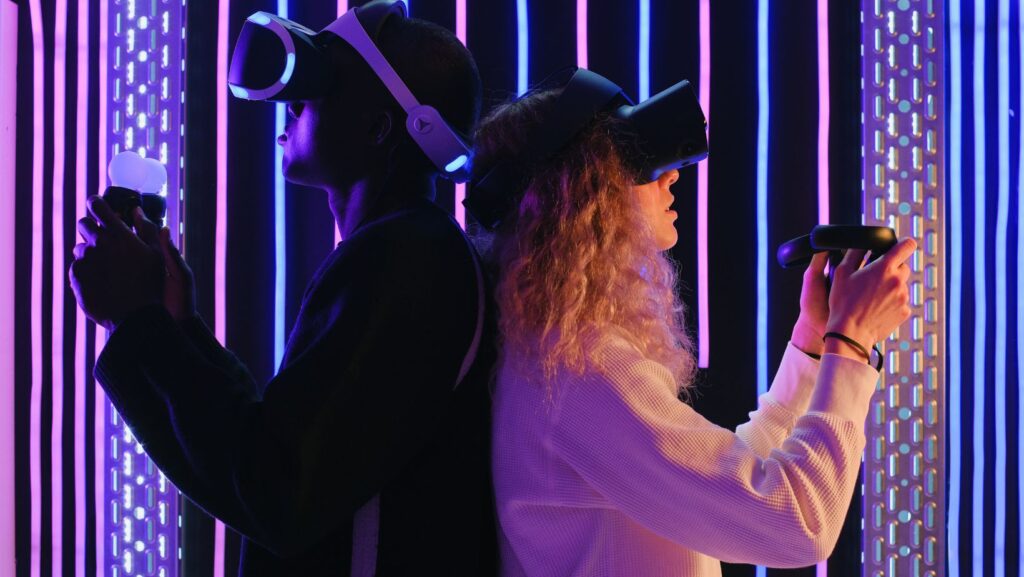Virtual reality (VR) has transcended the boundaries of mere gaming to become a battleground where technology meets limitless imagination. As players don headsets and grasp their controllers, they’re transported to arenas that defy the constraints of the physical world. VR battles offer an exhilarating blend of adrenaline and strategy, making them a rapidly growing phenomenon in the gaming community.
Virtual Reality Battles
The Technology Behind Virtual Reality Gaming
Virtual reality (VR) gaming employs advanced technologies to simulate dynamic environments and interactive experiences. At the core of VR gaming technology are three primary components: VR headsets, motion tracking devices, and powerful VR software.
VR Software
 The VR software orchestrates the whole experience by rendering lifelike scenes in real-time and managing the physics interactions within the game. It’s programmed to process input from trackers and adjust the visuals accordingly, ensuring that the virtual environment responds logically to each player’s movements. The seamless integration of software with hardware makes VR battles compelling and incredibly responsive.
The VR software orchestrates the whole experience by rendering lifelike scenes in real-time and managing the physics interactions within the game. It’s programmed to process input from trackers and adjust the visuals accordingly, ensuring that the virtual environment responds logically to each player’s movements. The seamless integration of software with hardware makes VR battles compelling and incredibly responsive.
These technological advancements are pivotal, allowing VR battles to deliver experiences that closely mimic real-world interactions while situated in fantastical or futuristic settings. As VR technology continues to evolve, the complexity and quality of virtual reality battles are set to improve, leading to even more engaging and realistic gaming adventures.
VR Headsets
VR headsets act as the gateway to virtual worlds, offering high-resolution displays and head-tracking capabilities. These headsets cover users’ eyes and provide a stereoscopic display, creating a convincing sense of depth and space. Popular models include the Oculus Rift, HTC Vive, and PlayStation VR.
Key Components of Virtual Reality Battle Games
Virtual Reality (VR) battle games merge cutting-edge technology and imaginative gameplay to offer unparalleled immersive experiences. Key components include hardware requisites and software intricacies, which play pivotal roles in crafting these engaging virtual environments.
Hardware Requirements and Options
 Expanding on the VR technologies discussed earlier, such as Oculus Rift and HTC Vive, virtual reality battle games demand high-performance hardware to provide seamless and immersive experiences. The primary hardware components necessary for VR gaming are:
Expanding on the VR technologies discussed earlier, such as Oculus Rift and HTC Vive, virtual reality battle games demand high-performance hardware to provide seamless and immersive experiences. The primary hardware components necessary for VR gaming are:
-
VR Headsets: Essential for visual and auditory immersion, VR headsets must deliver high-resolution displays and responsive head tracking. Options include the Oculus Quest 2, which offers a standalone experience, and the Valve Index, known for its superior image quality and field of view.
-
Controllers and Sensors: These allow users to interact with the virtual environment through physical actions mirrored in-game. The HTC Vive controllers, for instance, offer precision tracking and input variety, enhancing the tactile feedback essential for a realistic VR battle.
-
Powerful PCs or Consoles: If not using a standalone VR system, a powerful PC or a latest-generation console, like the PlayStation 5, is required. These systems need to have robust processing power and high-end graphics capabilities to handle the complex simulations in VR battles.
-
Room-scale Tracking Setup: To fully experience VR, players need physical space where they can move around safely. Systems like the Oculus Rift S include room-scale tracking with minimal setup, allowing a deeper level of physical engagement in games.
Software and Game Design Considerations
 For VR battle games to effectively captivate and maintain players’ interest, developers must consider both the technical software aspects and the creative design elements:
For VR battle games to effectively captivate and maintain players’ interest, developers must consider both the technical software aspects and the creative design elements:
-
Realistic Physics and Interactions: The software must realistically simulate physical laws to enhance believability. Games like ‘Half-Life: Alex’ leverage advanced physics engines to support intricate interactions with the environment, elevating the immersion factor.
-
Engaging Multiplayer Experiences: Software should support robust multiplayer functionalities that enable smooth interactions among players from various locations. This feature transforms virtual battles into social platforms, where strategy and communication are key.
-
Intuitive User Interfaces: Given the immersive nature of VR, interfaces must be intuitive and minimize disruption to the experience. Developers often integrate gestures and voice commands to streamline navigation and control, making the game experience as seamless as possible.
-
Scalability and Customization Options: Software architectures need to be flexible to accommodate different hardware configurations and personalization preferences. This allows for various visual settings to adjust according to user-specific hardware capabilities and comfort levels.



